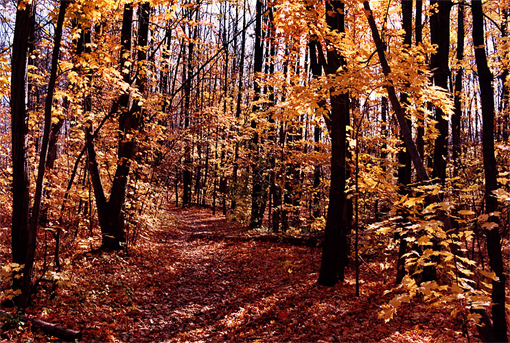Niagara Escarpment

The Niagara Escarpment is a beautiful and internationally recognized escarpment extending from New York through Ontario and Niagara Falls . With loads of recreational choices such as waterfalls, hills, wildlife, recreational trails, beaches, historic places, cities, hamlets and farms, the Niagara Escarpment becomes one of the most famous natural tourist spots in the world.
The Niagara Escarpment is a protected area and has been designated UNESCO World Biosphere Reserve in 1990. This natural landscape includes rich biodiversity and supports species of birds, reptiles, fish, mammals, orchids, Walking Fern and et al. The escarpment also includes Canada's oldest trail called "Bruce". Find camping sites and details of licensed day tours that are available in Niagara Falls.
The Bruce Trail
The Bruce Trail has probably inflicted more blisters, sore feet, and aching backs than any other trail in North America. But the aches and pains are well worth it as hiking the Bruce Trail, stretching 773 kilometres (480 miles) from Queenston Heights in the south to Tobermory at the northern end of the Bruce Peninsula, is a beautiful and rewarding experience.
The trail follows the cliffs of the Niagara Escarpment, a ribbon of near wilderness running through one of the most populated parts of the country. The place is also renowned for world famous wineries and vineyards. More than just a long ridge of rock, the Niagara Escarpment is a vital natural link, which ties together a rich tapestry of plant assemblages, bird life, animals, picturesque villages, and history. In recognition of its international importance as an ecosystem and its exceptional scenic beauty, the Niagara Escarpment Reserve was named a World Biosphere Reserve in 1990 by UNESCO.
The Bruce Trail is rugged in places and is punctuated by waterfalls cascading over steep dolostone cliffs. The trail is more than just a place to hike. It is also a link between delightful parks and conservations areas.
The Bruce Trail is marked with white blazes; that is, white rectangles that are approximately 6 inches (15 centimetres) high and 2 inches (5 centimetres) wide have been painted on trees, fence posts, and rocks, A turn is indicated by a pair of blazes, one above the other, with the upper one offset in the direction of the turn. In the Niagara area, there are numerous side trails that lead to various points of interest. These are also marked, but with blue or yellow blazes.
A detailed guide book to the Trail is available from the Bruce Trail. These web pages do not describe the Bruce Trail in its entirety through the Niagara area but, instead, describe selected portions that give good overviews of the natural setting of this region.



